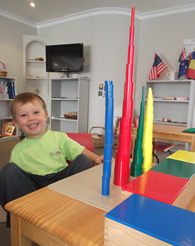Montessori Method

Maria Montessori's method is based on the profound respect
for the potential of the individual. Her theory was that children
learn best when they are able to follow their individual interests,
and that the child's "work" is to develop the person
he or she is to become.
The method is a highly hands-on approach to learning. It encourages
children to develop their observation skills by doing various
types of activities. These activities include the use of the
5 senses, spatial refinement, as well as small and large motor
skill coordination.
There are no grades, or other forms of achievement and assessment,
as Maria Montessori believed that this would be damaging to
the inner growth of the child. Each child is encouraged to
progress at his or her own level of readiness. We believe that
the accomplishment and behavior of the children, their concentration,
love of learning, maturity, happiness, and eagerness to come
to school speak for themselves, in more ways than a report
card ever could.
THE CLASSROOM
The Montessori classroom provides an atmosphere that
encourages children to explore and discover meaning for
themselves about
the world that surrounds them. It is a "prepared environment"
which allows children to learn at their own pace, choose
work of
their own choice, and interact with others in a natural,
respectful, and peaceful environment.
This "prepared
environment" is constituted of a number of distinct areas:
• Practical
life
• Sensorial
• Mathematics
• Language
• Cultural studies
• Creative
Classrooms are arranged in mixed age groups. This creates
a very rich educational experience. Children learn
from other classmates by looking at them work, which
builds
strong ties
of respect, cooperation, and develops their socialization.
They are invited to work in individual and uninterrupted
work
cycles in order to stimulate their power of concentration.
The class is run in such a way to promote the children's
freedom to make spontaneous choices, to be independent,
and to develop
a sense of responsibility within the group.
THE MONTESSORI MATERIAL

Maria Montessori designed her material to meet the
needs of children at each stage of their development,
what
she called «sensitive
periods». These «sensitive periods» can be
described as a specific time when children are more apt to
learn from and absorb particular experiences.
Each material isolates one quality, such as size,
colour, form, and texture, and has its specific
place in the
classroom. Each
piece of material is unique in the class. Indeed,
children must learn to be patient and wait for
their friend
to finish their work before he or she can work
on it themselves.
The material is self-correcting. There is no
need for adult correction – the child is
able to solve problems independently, which builds
his or her self-confidence and personal satisfaction
that comes from accomplishment.
|

